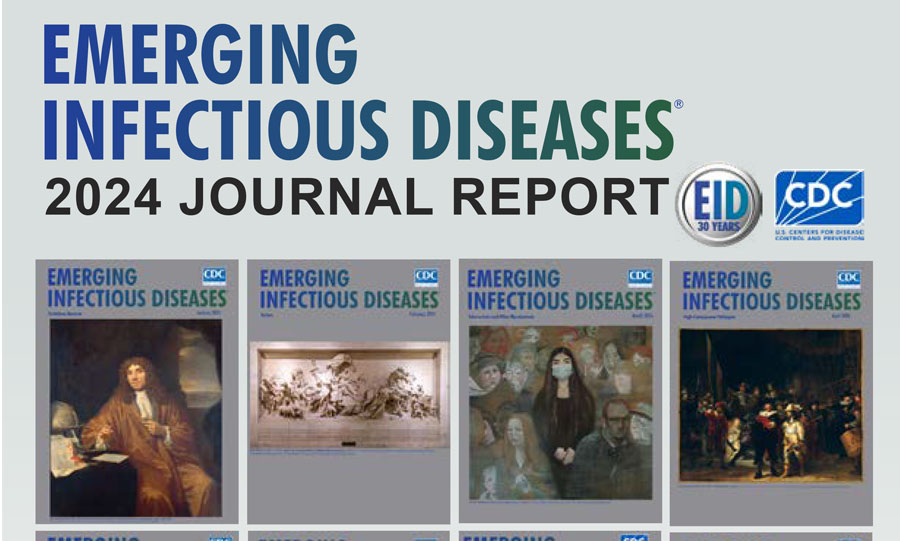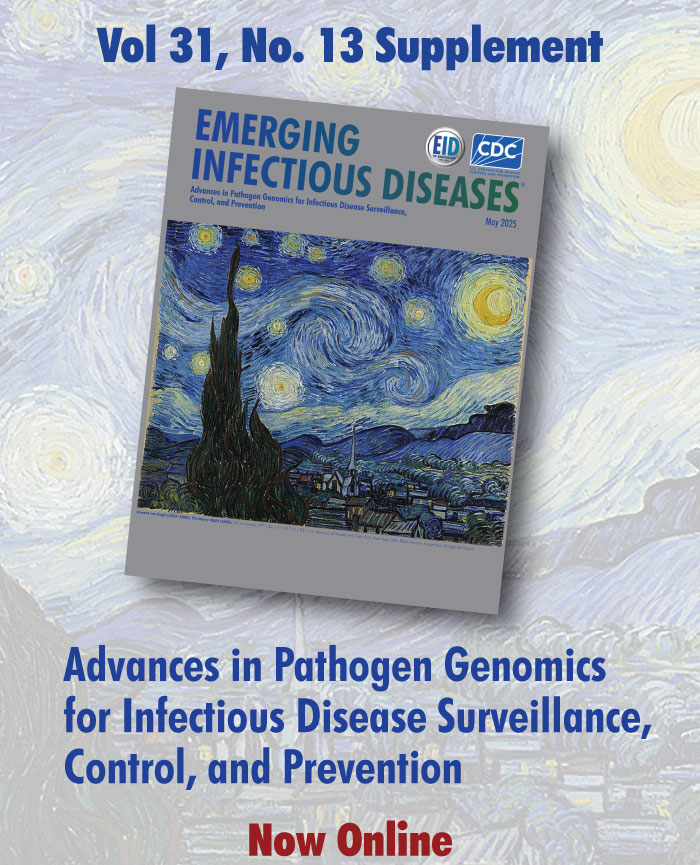Online Reports
Volume 29—2023
Volume 29, Number 10—October 2023
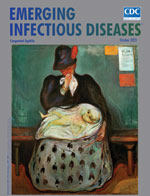
One Health Approach to Globalizing, Accelerating, and Focusing Amphibian and Reptile Disease Research—Reflections and Opinions from the First Global Amphibian and Reptile Disease Conference
The world’s reptiles and amphibians are experiencing dramatic and ongoing losses in biodiversity, changes that can have substantial effects on ecosystems and human health. In 2022, the first Global Amphibian and Reptile Disease Conference was held, using One Health as a guiding principle. The conference showcased knowledge on numerous reptile and amphibian pathogens from several standpoints, including epidemiology, host immune defenses, wild population effects, and mitigation. The conference also provided field experts the opportunity to discuss and identify the most urgent herpetofaunal disease research directions necessary to address current and future threats to reptile and amphibian biodiversity.
| EID | Gray MJ, Ossiboff RJ, Berger L, Bletz MC, Carter E, DeMarchi JA, et al. One Health Approach to Globalizing, Accelerating, and Focusing Amphibian and Reptile Disease Research—Reflections and Opinions from the First Global Amphibian and Reptile Disease Conference. Emerg Infect Dis. 2023;29(10):1-7. https://doi.org/10.3201/eid2910.221899 |
|---|---|
| AMA | Gray MJ, Ossiboff RJ, Berger L, et al. One Health Approach to Globalizing, Accelerating, and Focusing Amphibian and Reptile Disease Research—Reflections and Opinions from the First Global Amphibian and Reptile Disease Conference. Emerging Infectious Diseases. 2023;29(10):1-7. doi:10.3201/eid2910.221899. |
| APA | Gray, M. J., Ossiboff, R. J., Berger, L., Bletz, M. C., Carter, E., DeMarchi, J. A....Wilber, M. Q. (2023). One Health Approach to Globalizing, Accelerating, and Focusing Amphibian and Reptile Disease Research—Reflections and Opinions from the First Global Amphibian and Reptile Disease Conference. Emerging Infectious Diseases, 29(10), 1-7. https://doi.org/10.3201/eid2910.221899. |
Volume 29, Number 7—July 2023
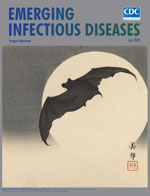
Epidemiology of Pathogens Listed as Potential Bioterrorism Agents, the Netherlands, 2009‒2019
We provide incidences (cases/10 million persons) in the Netherlands during 2009–2019 for pathogens listed as potential bioterrorism agents. We included pathogens from the highest categories of the European Medicines Agency or the US Centers for Disease Control and Prevention. Notifiable diseases and recently published data were used to calculate the average annual incidence. Coxiella burnetii had the highest incidence because of a Q fever epidemic during 2007–2010. Incidence then decreased to 10.8 cases/. Pathogens with an incidence >1 were Brucella spp. (2.5 cases), Francisella tularensis (1.3 cases), and Burkholderia pseudomallei (1.1 cases). Pathogens with an incidence <1 were hemorrhagic fever viruses (0.3 cases), Clostridium botulinum (0.2 cases), and Bacillus anthracis (0.1 cases). Variola major and Yersinia pestis were absent. The generally low incidences make it unlikely that ill-meaning persons can isolate these pathogens from natural sources in the Netherlands. However, the pathogens are stored in laboratories, underscoring the need for biosecurity measures.
| EID | Broertjes J, Franz E, Friesema I, Jansen H, Reubsaet F, Rutjes SA, et al. Epidemiology of Pathogens Listed as Potential Bioterrorism Agents, the Netherlands, 2009‒2019. Emerg Infect Dis. 2023;29(7):1-9. https://doi.org/10.3201/eid2907.221769 |
|---|---|
| AMA | Broertjes J, Franz E, Friesema I, et al. Epidemiology of Pathogens Listed as Potential Bioterrorism Agents, the Netherlands, 2009‒2019. Emerging Infectious Diseases. 2023;29(7):1-9. doi:10.3201/eid2907.221769. |
| APA | Broertjes, J., Franz, E., Friesema, I., Jansen, H., Reubsaet, F., Rutjes, S. A....Grobusch, M. P. (2023). Epidemiology of Pathogens Listed as Potential Bioterrorism Agents, the Netherlands, 2009‒2019. Emerging Infectious Diseases, 29(7), 1-9. https://doi.org/10.3201/eid2907.221769. |
Volume 29, Number 6—June 2023
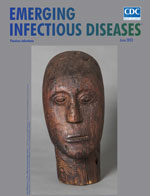
One Health Approach for Reporting Veterinary Carbapenem-Resistant Enterobacterales and Other Bacteria of Public Health Concern
A carbapenem-resistant Enterobacterales outbreak at a veterinary teaching hospital in the United States increased urgency for improved communication among diagnostic laboratories, public health authorities, veterinarians, and pet owners. Kansas State University, University of Missouri, Kansas Department of Health and Environment, and Veterinary Laboratory Investigation and Response Network created a surveillance, storage, and reporting protocol for veterinary antimicrobial-resistant bacteria; determined frequency of those bacteria in companion animals during 2018–2021; and created educational flyers for veterinarians and pet owners. We recommend a One Health strategy to create efficient surveillance programs to identify and report antimicrobial-resistant bacteria and educate veterinarians and pet owners about transmission risks.
| EID | KuKanich K, Burklund A, McGaughey R, Muturi N, Thomason S, Chengappa M, et al. One Health Approach for Reporting Veterinary Carbapenem-Resistant Enterobacterales and Other Bacteria of Public Health Concern. Emerg Infect Dis. 2023;29(6):1-9. https://doi.org/10.3201/eid2906.221648 |
|---|---|
| AMA | KuKanich K, Burklund A, McGaughey R, et al. One Health Approach for Reporting Veterinary Carbapenem-Resistant Enterobacterales and Other Bacteria of Public Health Concern. Emerging Infectious Diseases. 2023;29(6):1-9. doi:10.3201/eid2906.221648. |
| APA | KuKanich, K., Burklund, A., McGaughey, R., Muturi, N., Thomason, S., Chengappa, M....Gull, T. (2023). One Health Approach for Reporting Veterinary Carbapenem-Resistant Enterobacterales and Other Bacteria of Public Health Concern. Emerging Infectious Diseases, 29(6), 1-9. https://doi.org/10.3201/eid2906.221648. |
Volume 29, Number 5—May 2023
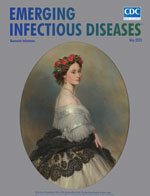
US National Institutes of Health Prioritization of SARS-CoV-2 Variants
Since late 2020, SARS-CoV-2 variants have regularly emerged with competitive and phenotypic differences from previously circulating strains, sometimes with the potential to escape from immunity produced by prior exposure and infection. The Early Detection group is one of the constituent groups of the US National Institutes of Health National Institute of Allergy and Infectious Diseases SARS-CoV-2 Assessment of Viral Evolution program. The group uses bioinformatic methods to monitor the emergence, spread, and potential phenotypic properties of emerging and circulating strains to identify the most relevant variants for experimental groups within the program to phenotypically characterize. Since April 2021, the group has prioritized variants monthly. Prioritization successes include rapidly identifying most major variants of SARS-CoV-2 and providing experimental groups within the National Institutes of Health program easy access to regularly updated information on the recent evolution and epidemiology of SARS-CoV-2 that can be used to guide phenotypic investigations.
| EID | Turner S, Alisoltani A, Bratt D, Cohen-Lavi L, Dearlove BL, Drosten C, et al. US National Institutes of Health Prioritization of SARS-CoV-2 Variants. Emerg Infect Dis. 2023;29(5):1-9. https://doi.org/10.3201/eid2905.221646 |
|---|---|
| AMA | Turner S, Alisoltani A, Bratt D, et al. US National Institutes of Health Prioritization of SARS-CoV-2 Variants. Emerging Infectious Diseases. 2023;29(5):1-9. doi:10.3201/eid2905.221646. |
| APA | Turner, S., Alisoltani, A., Bratt, D., Cohen-Lavi, L., Dearlove, B. L., Drosten, C....Smith, D. J. (2023). US National Institutes of Health Prioritization of SARS-CoV-2 Variants. Emerging Infectious Diseases, 29(5), 1-9. https://doi.org/10.3201/eid2905.221646. |
Volume 29, Number 4—April 2023
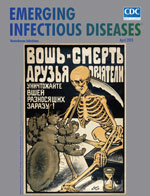
Global Veterinary Diagnostic Laboratory Equipment Management and Sustainability and Implications for Pandemic Preparedness Priorities
Substantial investments into laboratories, notably sophisticated equipment, have been made over time to detect emerging diseases close to their source. Diagnostic capacity has expanded as a result, but challenges have emerged. The Equipment Management and Sustainability Survey was sent to the Veterinary Services of 182 countries in mid-2019. We measured the status of forty types of laboratory equipment used in veterinary diagnostic laboratories. Of the 68,455 items reported from 227 laboratories in 136 countries, 22% (14,894/68,455) were improperly maintained, and 46% (29,957/65,490) were improperly calibrated. Notable differences were observed across World Bank income levels and regions, raising concerns about equipment reliability and the results they produce. Our results will advise partners and donors on how best to support low-resource veterinary laboratories to improve sustainability and fulfill their mandate toward pandemic prevention and preparedness, as well as encourage equipment manufacturers to spur innovation and develop more sustainable products that meet end-users’ needs.
| EID | Lasley JN, Appiah EO, Kojima K, Blacksell SD. Global Veterinary Diagnostic Laboratory Equipment Management and Sustainability and Implications for Pandemic Preparedness Priorities. Emerg Infect Dis. 2023;29(4):1-12. https://doi.org/10.3201/eid2904.220778 |
|---|---|
| AMA | Lasley JN, Appiah EO, Kojima K, et al. Global Veterinary Diagnostic Laboratory Equipment Management and Sustainability and Implications for Pandemic Preparedness Priorities. Emerging Infectious Diseases. 2023;29(4):1-12. doi:10.3201/eid2904.220778. |
| APA | Lasley, J. N., Appiah, E. O., Kojima, K., & Blacksell, S. D. (2023). Global Veterinary Diagnostic Laboratory Equipment Management and Sustainability and Implications for Pandemic Preparedness Priorities. Emerging Infectious Diseases, 29(4), 1-12. https://doi.org/10.3201/eid2904.220778. |
Volume 29, Number 3—March 2023
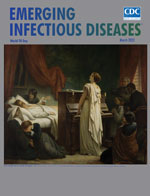
Interventions to Reduce Risk for Pathogen Spillover and Early Disease Spread to Prevent Outbreaks, Epidemics, and Pandemics
The pathogens that cause most emerging infectious diseases in humans originate in animals, particularly wildlife, and then spill over into humans. The accelerating frequency with which humans and domestic animals encounter wildlife because of activities such as land-use change, animal husbandry, and markets and trade in live wildlife has created growing opportunities for pathogen spillover. The risk of pathogen spillover and early disease spread among domestic animals and humans, however, can be reduced by stopping the clearing and degradation of tropical and subtropical forests, improving health and economic security of communities living in emerging infectious disease hotspots, enhancing biosecurity in animal husbandry, shutting down or strictly regulating wildlife markets and trade, and expanding pathogen surveillance. We summarize expert opinions on how to implement these goals to prevent outbreaks, epidemics, and pandemics.
| EID | Vora NM, Hannah L, Walzer C, Vale MM, Lieberman S, Emerson A, et al. Interventions to Reduce Risk for Pathogen Spillover and Early Disease Spread to Prevent Outbreaks, Epidemics, and Pandemics. Emerg Infect Dis. 2023;29(3):1-9. https://doi.org/10.3201/eid2903.221079 |
|---|---|
| AMA | Vora NM, Hannah L, Walzer C, et al. Interventions to Reduce Risk for Pathogen Spillover and Early Disease Spread to Prevent Outbreaks, Epidemics, and Pandemics. Emerging Infectious Diseases. 2023;29(3):1-9. doi:10.3201/eid2903.221079. |
| APA | Vora, N. M., Hannah, L., Walzer, C., Vale, M. M., Lieberman, S., Emerson, A....Epstein, J. H. (2023). Interventions to Reduce Risk for Pathogen Spillover and Early Disease Spread to Prevent Outbreaks, Epidemics, and Pandemics. Emerging Infectious Diseases, 29(3), 1-9. https://doi.org/10.3201/eid2903.221079. |
Volume 29, Number 1—January 2023
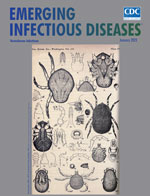
Efficiency of Field Laboratories for Ebola Virus Disease Outbreak during Chronic Insecurity, Eastern Democratic Republic of the Congo, 2018–2020
During the 10th outbreak of Ebola virus disease in the Democratic Republic of the Congo, the Institut National de Recherche Biomédicale strategically positioned 13 decentralized field laboratories with dedicated equipment to quickly detect cases as the outbreak evolved. The laboratories were operated by national staff, who quickly handed over competencies and skills to local persons to successfully manage future outbreaks. Laboratories analyzed ≈230,000 Ebola diagnostic samples under stringent biosafety measures, documentation, and database management. Field laboratories diversified their activities (diagnosis, chemistry and hematology, survivor follow-up, and genomic sequencing) and shipped 127,993 samples from the field to a biorepository in Kinshasa under good conditions. Deploying decentralized and well-equipped laboratories run by local personnel in at-risk countries for Ebola virus disease outbreaks is an efficient response; all activities are quickly conducted in the field.
| EID | Mukadi-Bamuleka D, Mambu-Mbika F, De Weggheleire A, Edidi-Atani F, Bulabula-Penge J, Mfumu M, et al. Efficiency of Field Laboratories for Ebola Virus Disease Outbreak during Chronic Insecurity, Eastern Democratic Republic of the Congo, 2018–2020. Emerg Infect Dis. 2023;29(1):1-9. https://doi.org/10.3201/eid2901.221025 |
|---|---|
| AMA | Mukadi-Bamuleka D, Mambu-Mbika F, De Weggheleire A, et al. Efficiency of Field Laboratories for Ebola Virus Disease Outbreak during Chronic Insecurity, Eastern Democratic Republic of the Congo, 2018–2020. Emerging Infectious Diseases. 2023;29(1):1-9. doi:10.3201/eid2901.221025. |
| APA | Mukadi-Bamuleka, D., Mambu-Mbika, F., De Weggheleire, A., Edidi-Atani, F., Bulabula-Penge, J., Mfumu, M....Ahuka-Mundeke, S. (2023). Efficiency of Field Laboratories for Ebola Virus Disease Outbreak during Chronic Insecurity, Eastern Democratic Republic of the Congo, 2018–2020. Emerging Infectious Diseases, 29(1), 1-9. https://doi.org/10.3201/eid2901.221025. |
